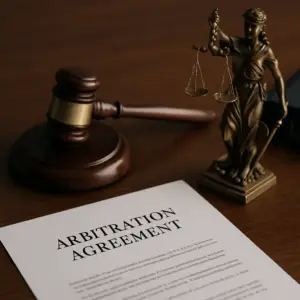Disputes Over Intellectual Property: When Arbitration Makes Sense
September 26, 2025
Share Article:
Settling disputes with our online arbitration services is easy, fast, and affordable.
We look forward to answering your questions and helping you to reach conflict resolution with our online arbitration service.

Handling Non-Compete Violations Without Going to Court
A non-compete agreement is a type of restrictive covenant commonly found in an employment contract. Employers often require employees to sign these contracts to prevent job hopping, safeguard trade secrets, and protect client relationships. At their core,

Arbitration vs. Litigation in Texas: A Cost Comparison
For Texas businesses facing legal disputes, selecting the right dispute resolution mechanism is a critical decision. Two common options are arbitration and litigation, each with distinct advantages, challenges, and cost implications.

How Freelancers Can Use Arbitration to Settle Payment Disputes
Freelancing offers freedom, flexibility, and the opportunity to shape your own career—but it also comes with risks. Chief among them? Clients who don’t pay. Whether you’re a graphic designer waiting on a final invoice or a developer facing payment disputes over

Commercial Arbitration Services in Los Angeles: What Businesses Need to Know
Los Angeles is home to one of the most sophisticated and dynamic business communities in the country. From startup founders to private equity funds and insurance companies, businesses in this region increasingly rely on alternative dispute

Is Arbitration Legally Binding? Understanding the Fine Print
If you’ve ever signed a contract for a job, a credit card, or even a cell phone plan, chances are you’ve agreed to arbitration—maybe without even realizing it. But is arbitration legally binding? And what does that actually mean for you as a consumer? Understanding
Why Arbitration Belongs On Your IP Dispute Roadmap
Intellectual Property is now the operating system of modern business. From trade secrets and design rights to copyright law, trademark law, and standards-driven patent portfolios, your IP rights often determine market position, valuation, and leverage in deals. When conflict hits, traditional litigation can be slow, expensive, public, and jurisdictionally messy. Alternative dispute resolution, especially arbitration, offers a private, expert-driven, and globally enforceable path that frequently aligns better with commercial timelines and cross-border realities in IP disputes.
Arbitration is not a second-class courtroom. Properly designed, it is an adjudicative proceeding administered by an ADR provider, heard by arbitral tribunals with subject-matter expertise, governed by agreed procedural rules, and ending in arbitral awards that are broadly enforceable under the New York Convention. The WIPO Arbitration and Mediation Center explicitly tailors case administration and neutral selection for technology and IP matters, maintaining a large panel of IP-savvy neutrals and offering expedited options for time-sensitive cases.
Global enforceability is the anchor of the value proposition. As of today, more than 170 jurisdictions are parties to the New York Convention, which enables recognition and enforcement of foreign arbitral awards with limited defenses. That reach is what makes arbitration a credible substitute for litigation in multi-jurisdictional IP portfolios where defendants, assets, and infringement acts span borders.
Arbitration vs. Litigation in IP: What Changes and What You Gain
Confidential proceedings. IP cases often turn on source code, confidential algorithms, vendor lists, or manufacturing methods. Arbitration keeps sensitive material away from public dockets and media cycles, protecting trade secret disputes and live product pipelines.
Subject-matter expertise. Parties can appoint arbitrators with patent, trademark, or licensing backgrounds, reducing time spent educating a generalist tribunal and increasing the quality of case management on issues like claim construction, FRAND disputes, and license agreements. WIPO highlights its 2,000-plus roster of IP-specialized neutrals for this reason.
Procedural flexibility and speed. The parties’ party agreement sets the arbitral procedure, with tailored disclosure, virtual hearings, agreed timing, and focused expert evidence. Many institutional rules provide streamlined tracks for fast decisions, and platforms support remote connection and secure sharing that fit distributed R&D teams. WIPO publishes clear steps, rules, and fee schedules for both regular and expedited arbitration to help counsel budget and plan.
Global enforceability. With New York Convention coverage across most trading nations, an award can be converted to a judgment and executed against assets in multiple states, an advantage over purely domestic court judgments in many scenarios.
Limits to remember. Arbitration’s privacy can reduce legal precedent development. Appellate review is narrow. Some remedies, like public law determinations or certain injunctive relief against third parties, may be trickier in arbitral settings. Where non-signatories or public regulatory interests are central, litigation or a mixed-mode ADR process may be better.
What IP Disputes Are Ripe for Arbitration
Not every IP conflict fits. The most arbitration-friendly profiles include:
Cross-border licensing and commercialization disputes. Royalty audits, milestone calculations, FRAND licensing disputes for standard-essential patents, research collaboration fallout, and breach of Representations and Warranties in technology M&A. These benefit from confidentiality, expert neutrals, and Convention-backed enforceability.
Contract-anchored disputes. Most arbitration flows from a clause in business contracts, technology transfers, joint development agreements, SaaS and cloud platform deals with digital signatures, or confidentiality agreements and trade dress co-existence arrangements. Contract anchors simplify consent and choice-of-law agreements.
Trade secret and know-how conflicts. Arbitration can mitigate the damage of public exposure and allow narrowly tailored provisional measures to preserve evidence and stop misuse, while keeping the ADR process off the public record.
Certain patent disputes. While validity against the world is a public law question in many systems, patent-related disputes that are fundamentally contractual—ownership, assignments, licenses, Markman debates framed as claim interpretation within a license, or quantum issues around royalty bases—are regularly arbitrated. WIPO and other institutions report steady growth in IP-arbitration caseloads reflecting this trend.
When in doubt, consider arbitrability rules where you operate. Party autonomy is strong, but public law limits can apply, and some jurisdictions constrain what can be decided in private fora. Party autonomy and applicable law choices are widely respected, yet they sit beside the territorial nature of IP and ordre public defenses.
Designing the Clause: Seats, Rules, Scope, and Relief
Arbitration works best when the clause is precise. Four levers matter:
Seat and scope. Pick a neutral or strategic seat with supportive courts and modern arbitration law. Define the disputes covered to include infringement, ownership, license interpretation, confidentiality, competition law defenses, and remedies. WIPO provides recommended clauses; many parties adapt them to include technology-handling protocols and protective orders.
Rules and institution. WIPO Rules are IP-focused, but AAA, SIAC, HKIAC, ICC, and others are common. The AAA Commercial Arbitration Rules include a dedicated mediation procedure that can be triggered during an arbitration, which is useful in IP matters where a business-savvy settlement preserves the relationship.
Interim measures. Provide for emergency relief and tribunal power to order preliminary injunctions, temporary restraining orders, and evidence preservation where the rule set allows. Many institutions empower tribunals to grant interim relief; national courts at the seat can also support provisional measures to protect IP while the case proceeds.
Enforcement, Public Policy, and Cross-Border Strategy
Enforcement is where arbitration earns its keep. Under the New York Convention, contracting states must recognize and enforce foreign arbitral awards subject to limited defenses, including incapacity, due process, excess of scope, procedural irregularities, and refusal where enforcement would violate public policy. Counsel should map target jurisdictions, assets, and any ordre public patterns that could affect IP-heavy awards, especially where moral rights or competition policy are sensitive. Official treaty resources track contracting states and typical reciprocity declarations so you can plan award conversion and execution.
In license heavy industries, overlapping proceedings are common. Good case management language can minimize conflicting results, provide consolidation or coordination across related arbitrations, and control discovery consistency. The AAA’s modern rules address consolidation and joinder mechanics, which can be adapted for multi-agreement technology stacks.
Where a settlement emerges from mediation, two global pathways exist. One is to convert the settlement to a consent award and ride the New York Convention. Another is to rely directly on the Singapore Convention on Mediation, which creates a framework for cross-border enforcement of international mediated settlement agreements. UNCITRAL’s text explains scope and exclusions, and scholarship summarizes how it complements, rather than replaces, arbitration enforcement routes.
Special Topics: FRAND, SEP Licensing, and Competition Overlays
Disputes over standard-essential patents and FRAND commitments illustrate arbitration’s strengths and limits. Multi-jurisdictional litigation can spiral into anti-suit injunctions and forum races. Arbitration centralizes rate setting and compliance, allows confidential economic modeling, and can bind cross-license structures across affiliates if drafted well. The tribunal can seat economists and technical experts to weigh FRAND disputes with industry data while preserving public interests through transparent reasoning shared under confidentiality.
Antitrust and competition law defenses sometimes require interface with national authorities. The clause should not attempt to oust mandatory competition scrutiny, yet arbitration can still adjudicate FRAND compliance, royalty bases, and geographical scope questions contractually. Where essential public enforcement is implicated, a mixed-mode process or limited carve-outs for regulatory filings keeps the award enforceable while respecting public regimes.
Unified Patent Court proceedings and European Union policy developments also affect forum design. For parties that want a private, portable, and expert forum parallel to the UPC, arbitration remains a logical layer for license and royalty issues, leaving validity or public injunctive outcomes to the appropriate public track when necessary. (Institutional materials from WIPO and others reflect these blended strategies in recent practice notes.)
Practical Playbook: From Filing to Final Award
Case administration and filings. File with your chosen institution. WIPO publishes checklists, comparison tables for standard vs expedited, and fee schedules. Sophisticated panels will schedule early case conferences to lock procedural rules, schedules, and secure data-handling.
Evidence and confidentiality. Build protective orders and data rooms for source code, CAD files, or biotech data. Agree on expert sequencing and hot-tubbing. Limit document production to what matters, using narrowly scoped requests that align with proportionality.
Interim relief. If your IP is at imminent risk, seek interim relief via emergency arbitrator or tribunal, or in supportive courts at the seat, to prevent irreparable harm while the case proceeds. Many rule sets expressly provide for such measures and coordination with national courts.
Hearing logistics. Today’s tribunals run hybrid or virtual hearings. Secure platforms, verified Wi-Fi connectivity, and clear exhibit protocols save time and cost—without compromising due process. WIPO and other institutions standardize online procedures that became mainstream during and after global disruptions.
Quantum and remedies. Expect rigorous economic analysis on lost profits, reasonable royalties, convoyed sales, and injunctive scope. Tribunals can issue permanent injunction orders in aid of contract rights, subject to the seat’s law and the agreed rules. Ensure your clause authorizes equitable relief where needed and clarifies how injunctive relief dovetails with court assistance.
Award drafting and scrutiny. Quality awards marshal facts, legal analysis, and remedy logic coherent with the contract and governing law. Some institutions offer optional award scrutiny to reduce enforcement risk. Consider requesting reasoned awards to aid predictability in future deals.
Mediation, Mixed-Mode Design, and the New Settlement Toolkit
Many IP battles end in business solutions, not zero-sum wins. Build settlement leverage into your design with mediation services and mixed-mode sequencing.
Front-loaded mediation. Early neutral evaluation or Good Offices can surface license paths or cross-supply agreements. The WIPO Mediation and Arbitration Center offers mediation, arbitration, and expedited options under one roof, making transitions smooth if settlement stalls.
Arb-Med-Arb. The SIAC-SIMC protocol pauses arbitration for mediation then converts settlement to a consent award, providing finality through New York Convention enforcement. Model clauses and guidance explain how to phrase the sequence and preserve tribunal independence.
AAA Rule 9 Mediation Procedure. In AAA practice, parties to a pending arbitration can attempt mediation without additional filing fees under the rule set’s mediation procedure, which lets you pivot to settlement without losing arbitration momentum. This is useful in IP licensing where market windows are short.
Singapore Convention option. If your deal resolves in mediation, you may rely on the Singapore Convention to enforce the written settlement across signatory states, or convert the settlement into a consent award to use the New York Convention route. Plan which instrument suits your enforcement map.
Recent Posts

Handling Non-Compete Violations Without Going to Court
A non-compete agreement is a type of restrictive covenant commonly found in an employment contract. Employers often require employees to sign these contracts to prevent job hopping, safeguard trade secrets, and protect client relationships. At their core,

Arbitration vs. Litigation in Texas: A Cost Comparison
For Texas businesses facing legal disputes, selecting the right dispute resolution mechanism is a critical decision. Two common options are arbitration and litigation, each with distinct advantages, challenges, and cost implications.

How Freelancers Can Use Arbitration to Settle Payment Disputes
Freelancing offers freedom, flexibility, and the opportunity to shape your own career—but it also comes with risks. Chief among them? Clients who don’t pay. Whether you’re a graphic designer waiting on a final invoice or a developer facing payment disputes over

Commercial Arbitration Services in Los Angeles: What Businesses Need to Know
Los Angeles is home to one of the most sophisticated and dynamic business communities in the country. From startup founders to private equity funds and insurance companies, businesses in this region increasingly rely on alternative dispute

Is Arbitration Legally Binding? Understanding the Fine Print
If you’ve ever signed a contract for a job, a credit card, or even a cell phone plan, chances are you’ve agreed to arbitration—maybe without even realizing it. But is arbitration legally binding? And what does that actually mean for you as a consumer? Understanding

